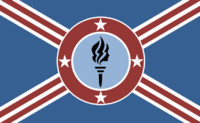Fluvannia
This article is incomplete because it is pending further input from participants, or it is a work-in-progress by one author. Please comment on this article's talk page to share your input, comments and questions. Note: To contribute to this article, you may need to seek help from the author(s) of this page. |
Federated Principality of Fluvannia | |
|---|---|
|
Flag | |
| Motto: Ex Fortitudine Pax ("Peace Through Strength") | |
| Capital | Oshkosh |
| Largest city | Rochester |
| Demonym(s) | Fluvannian |
| Government | Federal constitutional monarchy |
• Crown Prince | Michael |
| High Council | |
| House of Delegates | |
| Area | |
• Total | 1,103,200 sq mi (2,857,000 km2) |
| Population | |
• 2019 estimate | 19,415,000 |
• 2010 census | 16,980,208 |
• Density | 17.6/sq mi (6.8/km2) |
| GDP (PPP) | 2019 estimate |
• Total | $1.371 trillion |
• Per capita | $70,616 |
| Currency | Mark |
| Driving side | right |
| Calling code | +13 |
| Internet TLD | .fl |
Fluvannia (officially the Federated Principality of Fluvannia) is a nation comprised of three discontiguous regions in northern and eastern Abos. The capital, in the northwestern part of the country, along the shore of Lake Winnebago, is Oshkosh; the largest city is Rochester, located in the smallest of the three regions, the centrally-located County of Monroe. Other major cities include Charlottesville, Green Bay, Appleton, and Scottsville.
Formed in the early 19th century from what had been a personal union of three separate polities, Fluvannia is as a result a large and geographically diverse nation, inhabited by approximately 19.42 million people (2019, est.). Fluvannian territory has been inhabited for millennia by various peoples; indeed, a reference in an account to the "populus qui colunt fluvium annum" ("the people who cultivate the yearly river"), describing the villages along the Rivanna River, shows that agriculture had been associated with the Charlottesville area since antiquity. Likewise, in the north, references to the hunter-gatherer Viinebeiko people -- often in the context of pillaging -- can be found in Iron Age manuscripts. Over time, various feudal realms arose in each of the three regions, resulting in a complex network of intermarriages, rival claims, and warfare. Sometimes these realms would turn to outsiders for help; one of these such marital alliances, between Thomas, Duke of Piedmont and Joanna, Countess of Monroe in 1213, would lay the groundwork for the modern Fluvannian state.
A federal constitutional monarchy, Fluvannia is comprised of two duchies and a county, each of which possess a high degree of autonomy. Unlike many constitutional monarchies, the Fluvannian monarch, titled the Crown Prince, plays an active but nonpartisan role as the head of the nation's executive branch. Over 1.8 million people live in the Greater Rochester area, the largest in the country, which has functioned as a hub for trade since medieval times. A long process of noble marriages and inheritances brought increasing power to the respective nobles of the now-Fluvannian constituencies, but in the Enlightenment Era much of this power was devolved to local and regional governments. The Act of Union of 1826 saw the Duchy of Winnebago, the Duchy of Piedmont, and the County of Monroe united under a single legal crown.
From the tundra and tiaga north of the Arctic Circle, to the temperate Achrinian Ocean coastline of the Duchy of Piedmont, to the dry, boreal savannah of the Abosian interior, the Fluvannian landscape plays host to a number of different biomes.

